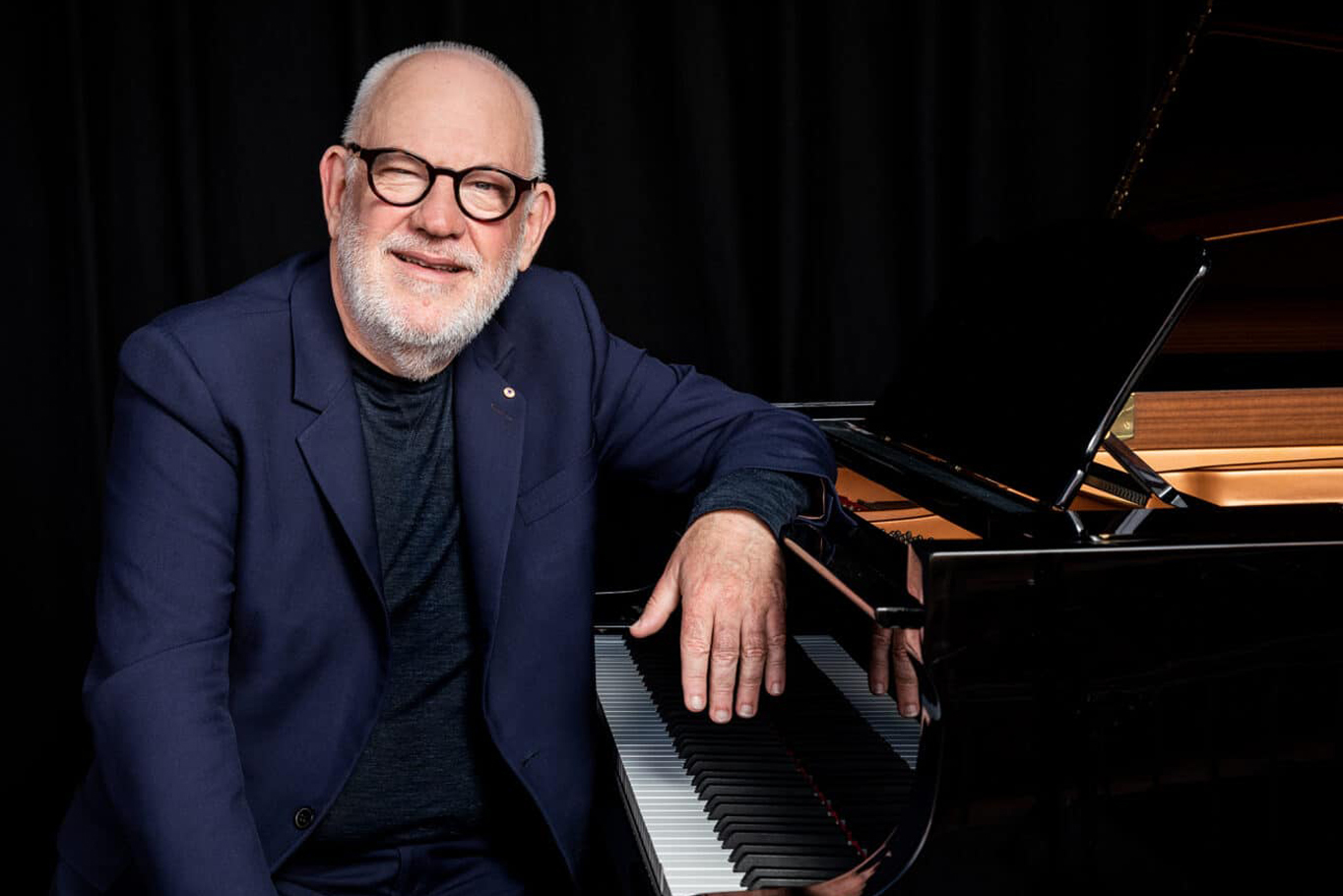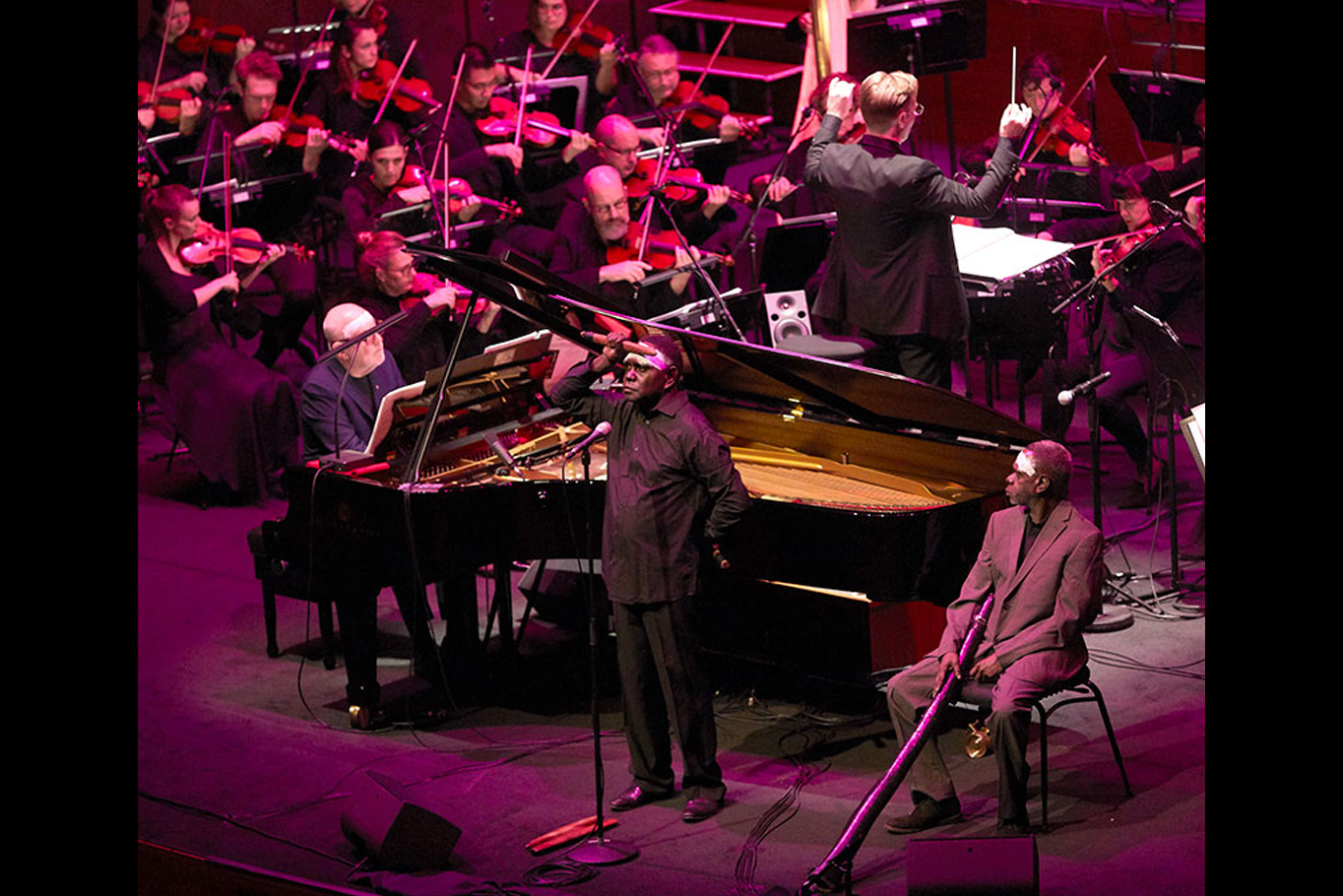
Something in the Wata
14 June, 2024
Paul Grabowsky has spent two decades exploring ways to combine ‘Western’ musical tradition with the traditions of the world’s oldest-continuing culture. With Wata, which receives its Sydney premiere this July, he has arrived somewhere new, old, familiar and unique all at the same time.
By Hugh Robertson
Western classical music claims for itself musical traditions going back 1,500 years, right back to the development of monophonic or Gregorian chant – also known as plainsong – in the fifth century. It is an extraordinary cultural legacy, full of tremendous richness, the quality of the music reinforced by continuing practice over centuries and the devotion of entire ecosystems to its preservation.
This July, the Sydney Symphony Orchestra will combine that millennia of inheritance with a tradition more than 50,000 years in the making. Wata is an ambitious and beautiful new work that brings together three distinct musical forms – orchestral music, improvised music, and the traditional ceremonies of the people of south east Arnhem Land in Australia’s Northern Territory – to create something totally unique yet profoundly human.
‘Wata is a seven-movement piece which brings together a large-ish symphony orchestra, a bunch of improvising soloists and the Wilfred Brothers,’ explains Paul Grabowsky. ‘They, during the course of the performance, lay out this song cycle, which is called the Djuwalpada cycle. And essentially what it is about is the interconnectedness of all things.’
Grabowsky is one of the driving forces behind Wata, the latest in a long series of projects where he has sought to find ways of combining traditional First Nations music and ceremony with the sounds of capital city concert halls that audiences are more familiar with. The heart of that seven-movement piece he describes is the Djuwalpada cycle, about a creator figure wandering the land, ‘singing up the land’ in an act of creation, creating spears for hunting, bags for carrying food, and inventing dance for ceremony.
‘Djuwalpada is present in all of these things,’ Grabowsky concludes. ‘So he is the instigator, he is the protagonist, but he is also the embodiment of all of these things as well. And in the final movement, he becomes his totem, which is the Birrik Birrik – a bird, a plover – and he flies away.
‘It’s a big cycle about life and regeneration, and how everything interconnects. And the work attempts to express this proposition in its form. So the work brings together these different elements and allows these different elements to connect with each other as well.
‘You've got the Wilfreds; you've got the improvising soloists who play interstitial improvisations between the movements, which are also in dialogue with the Wilfreds, so they have an interactive role in those as well. And Daniel and David, they sing sections of the of the Djuwalpada cycle across the orchestral music that I've created.’

In truth there could not be anyone better suited to this ambitious crossover: Grabowsky is one of Australia’s great musical polymaths, a seven-time ARIA Award winning pianist, composer, professor and collaborator, he has worked with an extraordinary list of people across genres and styles, from playing piano with Chet Baker to writing albums with Paul Kelly, mentoring a young Megan Washington, and composing scores for stage and screen. Tony Way in The Age once described him as ‘something of a musical magpie’ for his curiosity and his intelligence, and in 2014 he was awarded the Order of Australia (AO) for services to music as an educator, mentor, composer and pianist.
The road to Wata began 20 years ago, when Grabowsky first travelled to Arnhem Land to explore potential musical collaborations.
‘I went up there in 2004, hoping to meet with some traditional people who might give me some insight into what they were doing,’ he explains. ‘Not from an ethnomusicological point of view – I wasn't really interested in slicing and dicing. I really wanted to see if it was even conceivable to do some kind of collaborative project.’
‘At the time I was the artistic director of the Australian Art Orchestra, and a lot of what drives the AAO is this idea of allowing improvised music to build bridges between different kinds of music making. So [the Wilfreds] seemed very intrigued by this, and about a year after my first trip, I went back into the community again with about ten members of the orchestra…and they started to teach us these manikay.’
Manikay is a crucial concept to understand when talking about Wata. At their basic level manikay are songs, but they are also so much more than that: they are part of a ceremony but also the ceremony itself, they carry important messages and stories about the world, history and people, including what we might describe as morals or fables.
It’s not really something that exists in 21st-century Western concepts of music and performance – the closest comparison might be ancient Greek theatre, which also combined all these elements into something that was both entertainment and cultural transmission,
‘Yeah, absolutely,’ says Grabowsky when I explain that this was my way into understanding Wata. ‘That was a ritual framework within which a society would come together and experience that sort of mythologising storytelling – which at the same time is redemptive, it's didactic, it's an opportunity for the society to come together and understand something more about themselves and about each other. So, yeah, it's a reasonable point of comparison.’
‘I have always railed against the enforced categorisation which we experience in music. Terms like ‘classical music’ and ‘jazz’, for me, are 20th century terms really. But I don't really accept that they are necessarily 21st century terms. “Jazz” for me has been a way of learning about music, especially a way of learning how to be an improvising musician. But it's only one of the improvised music traditions in the world. Most music – if you think about it – is improvised music. The amount of music which is a kind of classical music, whether it's Western or Indian classical music or whatever other classicising traditions there are, they are a minority really in the totality of musical forms of expression.
‘So the idea of bringing a number of these worlds together into a piece like Wata, for me, is kind of normal practice. I mean, that's what I've been pursuing with the AAO over the nearly 20 years that I was leading it, but it's still my guiding philosophy about music. I've written fully notated music, of course. In fact, the last piece I wrote for the MSO [when he was their 2022 Composer in Residence] was a completely fully notated 14-minute piece for orchestra. So I'm not averse to it.
Things like Wata are deeply satisfying on such a kind of profound level, because it's not just about the music. The music is a kind of vehicle for it, but it's the idea that it's expressing.
Manikay has been central to Grabowsky’s artistic output over the past two decades, but even after all that time steeped in the tradition he is still having profound epiphanies about it.
‘There was something about it that I had not comprehended until quite a long way into this journey,’ he says, his voice full of wonder and inspiration. ‘I imagined when I started doing these collaborations that that's what they were. That we were bringing a musical language into a conversation with their musical language – essentially, that it was a conversation, a knowledge exchange.
‘But what I had failed to comprehend until quite a bit later was that from their perspective, what was happening was that we were becoming part of the manikay. If they give us permission to perform within the manikay kind of paradigm, we're in it. Manikay is a very generous act of sharing, and if you're brought into that circle, then all you're really doing is adding to what is essentially this incredible value proposition about interconnectedness.
So you're not a separate thing. It's not subject/object. It's not two things coming together. It's just an expression of that one thing from their point of view.’

These performances will mark the Sydney debut of Wata, and the first performance of the work since its world premiere in Melbourne in 2021, and Grabowsky is thrilled to have the chance to revisit it.
‘It’s terribly exciting for me,’ he says with a big smile. ‘It's sort of my debut, I guess, with the Sydney Symphony Orchestra, in a sense – I have played with the orchestra on one occasion, but not my music. So I'm just thrilled.’
And to bring this work into the Opera House also, I think is very powerful and significant moment for me. It'll be very significant for the Wilfreds, I know that.
‘But we all love to do this piece. It is very uplifting. So, yeah. I'm just grateful for any opportunity to perform it really.
‘I’m in music in order to communicate with audiences, to share something with them which hopefully lifts us all up in some sort of way, that everybody feels a little bit better off for the experience. That's what music is about as far as I'm concerned. If it doesn't achieve that, then there's something not working in it.’
Book Your Tickets
Wata: a gathering for songmen, improvising soloists and orchestra
In one of the most innovative and energising works for 2024, composer and pianist Paul Grabowsky brings the Sydney Symphony Orchestra and Yolŋu songmen Daniel Ngukurr Boy Wilfred and David Yipininy Wilfred together in a work that celebrates the musical traditions of the Ngukurr people in Arnhem Land.
24 July | Sydney Opera House Concert Hall
